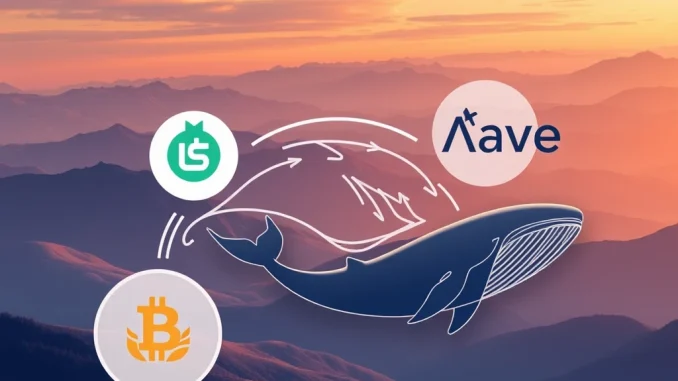
Imagine seeing $300,000,000 appear on a blockchain tracker. That’s exactly what happened recently, catching the eye of many in the crypto world. A massive USDT transfer, totaling a staggering $300 million, was reported moving from an unidentified wallet straight into Aave, one of the largest decentralized finance (DeFi) lending protocols.
The Massive USDT Transfer Reported by Whale Alert
The alert came from Whale Alert, a service that tracks large cryptocurrency movements across blockchains. Their report highlighted a significant USDT transfer: 300,000,000 Tether tokens changing hands. The source was tagged simply as ‘unknown wallet,’ adding a layer of intrigue to the transaction. The destination? Aave.
This isn’t just a large number; it represents a considerable sum of value entering the DeFi ecosystem via a major protocol like Aave. Such movements are closely watched because they can signal potential market activity or strategic positioning by major players.
Why Deposit Such a Large Crypto Transaction on Aave?
Putting $300 million into Aave isn’t like sending money between bank accounts. Aave is a decentralized platform where users can lend and borrow various cryptocurrencies. Depositing assets like USDT into Aave makes them available for others to borrow, and in return, the depositor earns interest (yield) on their holdings.
A large crypto transaction of this magnitude could have several motivations:
- Earning Yield: The simplest reason is to earn passive income on a significant USDT holding by lending it out on Aave.
- Establishing Borrowing Power: Depositing assets allows the user to borrow other cryptocurrencies against their deposited collateral. A $300M deposit provides immense borrowing capacity.
- Strategic Positioning: The owner might be preparing to borrow funds for other investments, trading strategies, or to participate in other DeFi protocols.
- Seeking Stability: While holding a large amount of any asset carries risk, USDT is a stablecoin, designed to maintain a 1:1 peg with the US dollar. Parking it on Aave could be a way to keep funds relatively stable while still generating a return.
Decoding the Potential Motives of a Crypto Whale
When we talk about wallets moving hundreds of millions, we’re often talking about a crypto whale – an individual or entity holding and moving vast amounts of digital assets. The actions of whales are significant because they can potentially influence market dynamics due to the sheer volume of their transactions.
A whale moving $300M into Aave suggests confidence in the Aave protocol and the stability of the DeFi lending market. It could be a long-term play for yield, or it could precede a major borrowing action that might impact the markets for other assets.
Consider these points regarding whale behavior:
| Action | Potential Motivation | Market Implication (Possible) |
|---|---|---|
| Deposit to Lending (Aave) | Earn yield, gain borrowing power | Increases protocol liquidity, potential for future borrowing activity |
| Withdrawal from Exchange | Long-term holding, self-custody | Reduced immediate selling pressure |
| Deposit to Exchange | Prepare for selling, trading | Increased potential selling pressure |
This particular USDT transfer falls into the first category, adding significant capital to the DeFi lending pool.
What This Means for Aave and DeFi Liquidity
The arrival of $300 million in USDT is a major boost for DeFi liquidity on Aave. Liquidity is crucial for lending protocols; it’s the pool of assets available for borrowing. More liquidity generally means:
- Lower borrowing interest rates (due to increased supply).
- Higher lending interest rates (though large deposits can sometimes dilute rates if not quickly borrowed).
- Greater capacity for large borrowers.
- Increased stability for the protocol.
This single deposit significantly increases the amount of USDT available on Aave, making it easier and potentially cheaper for others to borrow USDT, and providing more collateral for users looking to borrow other assets like Ether or Bitcoin.
The Enduring Mystery of the Unknown Wallet
Perhaps the most intriguing aspect of this large crypto transaction is that the source is an ‘unknown wallet.’ While blockchain transactions are public, the identity behind the wallet address is often not. This fuels speculation: Is it an institution? A large individual investor? An early adopter? A fund?
The lack of clear identification is common in the crypto space but adds an element of mystery to such significant movements. It highlights the pseudonymous nature of blockchain transactions, where activity is transparent but the actors remain hidden unless they voluntarily reveal themselves or their identity is linked through other means.
Summary: A Massive Influx into DeFi
The reported USDT transfer of $300 million from an unknown wallet to Aave is a notable event in the cryptocurrency space. It represents a significant capital injection into the DeFi lending ecosystem, boosting DeFi liquidity on one of its leading platforms. While the identity of the crypto whale behind this large crypto transaction remains a mystery, their move signals confidence in Aave and potentially precedes further strategic actions within the DeFi landscape. Keeping an eye on such large on-chain movements provides valuable insight into where major players are positioning themselves in the market.



